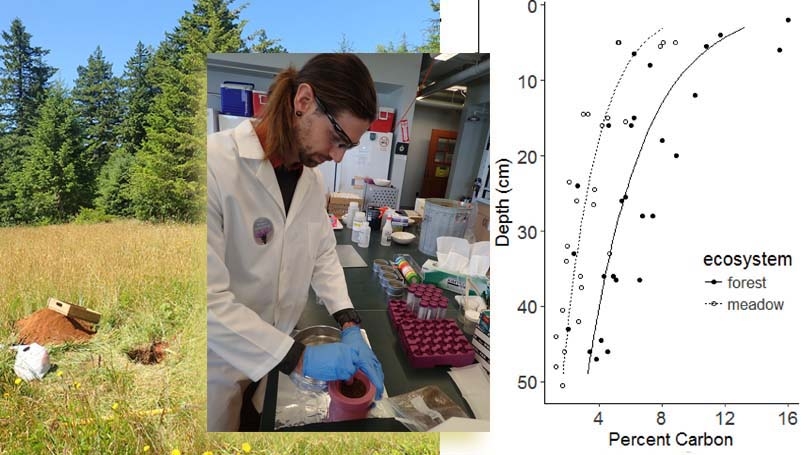
Braden Elliott works on soil samples gathered from meadows in Western Oregon with carbon measurements recorded in the graph to the right. (Images: Braden Elliott)
Thanks to the generosity of alumni from the School of Graduate and Advanced Studies, several current students are able to receive funds to support their research endeavor off campus. Each recipient is required to submit a short overview of how the award contributed to their work.
Perhaps you have found yourself in a grassy opening in the woods and wondered why the forest has not taken it over. If so, you are in good company—ecologists have been studying the factors regulating grassland-woodland dynamics since the discipline was formalized in the late 19th century. One “field” of study (pun intended) attempts to understand why meadows persist in mountainous forests at temperate latitudes. This phenomenon is studied in places such as the Appalachians in the eastern United States, the Carpathians in Eastern Europe, and the coastal ranges along the West Coast of North America.
I work in western Oregon, a region many consider the most productive timberland in the world. This region includes the Oregon Coast Range and the southern Cascade Range. Almost all of our knowledge about meadow persistence in western Oregon comes from study in the Cascades; only a handful of studies have looked at grassy balds in the temperate rainforest of the Oregon Coast Range. I am working to balance this body of knowledge by studying persistent meadows on other kinds of topography in the Oregon Coast Range. This work is important because trees and shrubs have been increasingly encroaching into grasslands all over the world in the last century, and meadows represent valuable habitat for endangered plants and animals as well as game animals such as elk and deer. Land managers, including Tribal, state, and Federal entities, have prioritized meadow conservation in this region. We live in a rapidly changing world, and so we increasingly need new knowledge about ecological resilience.
For my dissertation, advised by Nick Reo in the Ecology, Evolution, Ecosystems, and Society Program, I study five of the nine persistent meadows—all previously unknown to the scientific literature—on public land in the central Oregon Coast Range. I identified these sites with help from US Forest Service researchers at Siuslaw National Forest and the Pacific Northwest Research Station. I spent the summers of 2015 and 2016 pursuing three interrelated projects: a field experiment on effects of neighboring plants and large mammal herbivores on Doug-fir (Pseudotsuga menziesii, the predominant plant in all timber units in this region); a structured observation of the effect of herbivores across the edge from the meadow into the forest; and soil profiles comparing each meadow to the surrounding forest. I was able to complete data collection for the first two projects in all five meadows, but I was only able to sample soils at three meadow locales before 2017. The Alumni Research Award in 2017 allowed me to travel to Oregon and sample soils at the two remaining meadow locales and to transport those samples to the Environmental Studies laboratory at Dartmouth for analysis. I would like to thank the Alumni Research Award donors for making it possible for me to finish work in the field and in the lab for this project.
With complete data for all study sites, I have been able to build a foundation for understanding meadow persistence in the temperate rainforest of the Oregon Coast Range. I found that herbivores significantly reduced tree seedling growth in meadows, but they browse just as heavily in the surrounding forest as they do in the meadows. I also found that neighboring plants have no effect on seedling growth. These meadows, therefore, probably do not persist because competitive herbs or hungry herbivores keep trees out. Belowground, on the other hand, I found some interesting differences between meadow and forest soils: meadow soils are finer; lower in carbon and nitrogen; have a lower ratio of carbon to nitrogen; and are less acidic (all relative to forest soils).
This new knowledge opens the door to some interesting future work, as it is unclear whether these soil properties straightforwardly determine plant community, or if plant-soil feedbacks create or amplify differences in soil properties over time. These results will contribute to the management of important wildlife habitat, the study of temperate montane meadow persistence, and our urgent quest to understand ecological resilience in a rapidly changing world.